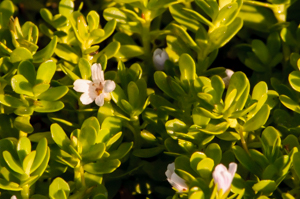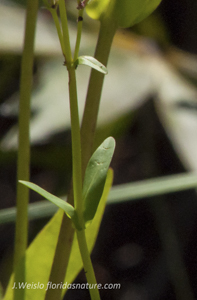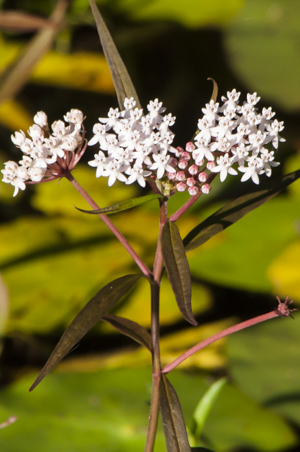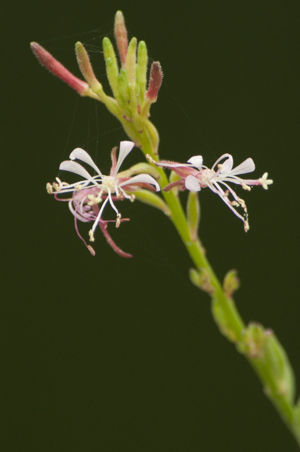Florida's Wildflowers
White
On this page - White-top Aster, Hammock Snakeroot, Purple Thistle, Southern Fleabane, Tenangle pipewort, Frostweed, Spring Ladies Tresses, Herb-of-Grace, Manyflower Beardtongue, Lizards Tail, Aquatic Milkweed, Southern Beeblossom
White-top Aster - Oclemena reticulata


Family - Asteraceae
Habitat - Wet Pine flatwoods, other moist areas
Description - 1 1/2 to 2 inch flowers with white petals surrounding a yellow central disk. Leaves are variable in shape, sessile or nearly so, elliptic to obovate & pubescent.
White-top Aster is a common Florida native plant that blooms from spring though fall & grows to about 3 feet tall.
Purple Thistle - Cirsium horridulum Michx.
_small.jpg)

Family - Asteraceae
Habitat - Pinelands, Prairies, well drained sandy soils
Description - Large basal rosette, broader than tall. 12-18 inches in height, to 3 feet or more when in flower. Spiny leaves.
Flower - 2-3 inches across ranging in color from purple to pink or white. Host plant for many butterfly and insect larvae.
Southern Fleabane, Oakleaf Fleabane - Erigeron quercifolius
_small.jpg)
%20detail_small.jpg)
Family - Asteraceae
Habitat - Pinelands, prairies
Description - Native herbaceous perennial, 3 inches to 3 feet in height. Leaf and stems hairy. White to lavender flower, 3/4 inch in diameter with many fine rays surrounding a yellow central disk.
Tenangle Pipewort - Eriocaulon decangulare


Family - Eriocaulaceae
Habitat - Bogs, Marshes, Wet Flatwoods
Description - Linear leaves 10-40 cm. long form a basal rosette, white flowered hemispheric to nearly globose inflorescenceson a scape to 3 feet long.
Frostweed - Verbesina virginica L.



Family - Asteraceae
Habitat - Present in most upland habitats with the exception of scrub.
Description - Florida native plant to over eight feet high, this plant may grow as a biennial or a perennial. Also called Indian tobacco by some it was apparently used by native Americans and early settlers as a tobacco substitute. It gets the common name of frostweed from the formations of ice that frequently occur from the bases of split stems after the first frost.
Spring Ladiestresses - Spiranthes vernalis



Family - Orchidaceae
Habitat - Marshes, Wet Flatwoods & Freshwater swamps throughout Florida.
Description - Grows to 25 inches tall and in spite of its common name this plant often blooms well into the summer months. Other common names include Grass-leaf Ladies Tresses and Narrow Leafed Ladies Tresses. 25 - 50 flowers are on inflorescences and are densely arranged in a single ranked formation, one sided or spiraled around the stalk. Flowers are under just 1 millimeter in diameter, tubular, white to cream colored with a yellow center. Flower petals have wavy to somewhat ragged appearing margins.
Herb-of-Grace - Bacopa monnieri

Family - Plantaginaceae
Common names include - Water hyssop, Brahmi, Thyme-leafed gratiola, Herb of grace, and Indian pennywort. Bacopa monnieri is a perennial, creeping herb native to marshy areas throughout Florida. Bacopa monnieri leaves are succulent and relatively thick. Its leaves are only 1/8 inch wide and 5/8 inch long. Leaves are oblanceolate, arranged oppositely on the stem, and 1-veined. Flowers are small and white, with 4 or 5 petals.
Manyflower Beardtongue - Penstemon multiflorus


Family - Scrophulariaceae
Manyflower beardtongue, also known as White beardtongue, is a deciduous perennial common throughout Florida on well drained sandy soils, dry pine flatwoods and sand-hill habitat. White tubular, 5 lobed, 2-lipped flowers are produced from late spring through early summer on stalks arising from a basil rosette of grayish-green leaves. Flower stem leaves are sessile and oppositely arranged.
Lizards Tail - Saururus cernuus

Family - Saururaceae
Common names include American Swamp Lily, Lizard's Tail, and Water-dragon. A herbaceous perennial of the eastern half of the United States and Canada. Grows as a emergent wetland plant and in sun or shaded lowland and periodically flooded areas in wet soils, mud. Up to 4 feet high with a 2 foot spread. Propigation is by root and seed.
Leaves are alternate, 3-6" bright green, lance-shaped to triangular with heart-shaped base and entire margins, on a zig-zag stem. Flowers are small fragrant, white, produced on a raceme in the spring and summer.
Aquatic Milkweed - Asclepias perennis

Family - Apocynaceae
Also called Swamp milkweed, an important host and necter plant for Monarch and Queen butterflies.
Height to about 3 feet on wet and flooded soils in full sun to partial shade, leaves are opposite, linear to a narrow elliptic shape, 3-5 in (8-13 cm) long by 1/2-1 1/2 in (1-4 cm) wide with entire margins. Leaf vein and underside are a duller green. Stems are a light pink color, tips of un-opened flower buds also pink. White flowers are produced during the warmer months, typically from May through September.
Southern beeblossom - Oenothera simulans

Family - Onagraceae (Evening primrose family)
A.K.A. - Slender-stalked beeblossom
A native erect herbaceous annual or perennial found throughout Florida and the south-eastern U.S.. Southern beeblossom may be found growing in dry,sandy soils of open scrub and flatwoods.
Small, white, flowers having 4 petals are produced from spring through fall on slender branching spikes 4 - 6 feet tall arising from a basil rosette, the flowers opening in the evening and turning pink-ish and then withering by the next day. As its name implies the flowers attract bees and other pollinators and southern beebloosom is also the host plant for the larvae of the clouded crimson moth, a nocturnal pollinator.
